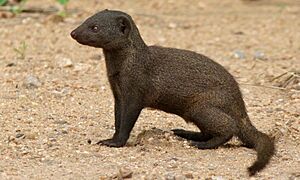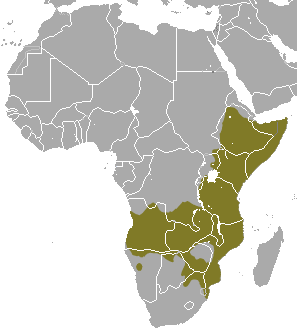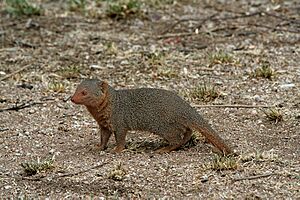Common dwarf mongoose facts for kids
Quick facts for kids Common dwarf mongoose |
|
|---|---|
 |
|
| in Kruger National Park | |
| Conservation status | |
| Scientific classification | |
| Genus: |
Helogale
|
| Species: |
parvula
|
 |
|
| Common dwarf mongoose range | |
The common dwarf mongoose (Helogale parvula) is a small mongoose species. You can find them in parts of Africa. These areas include Angola, northern Namibia, and East Africa. They also live in South Africa's KwaZulu-Natal and Zambia. This mongoose is part of the Helogale group.
What They Look Like
The common dwarf mongoose has soft fur. Its color can be yellowish-red to very dark brown. It has a large, pointed head and small ears. It also has a long tail, short legs, and long claws. This animal is Africa's smallest meat-eating mammal. It is about 16–23 cm (6.3–9.1 in) long. It weighs around 213–341 g (7.5–12.0 oz).
Where They Live
Common dwarf mongooses live across a wide area of Africa. Their home stretches from Eritrea and Ethiopia in East Africa down to South Africa. They mostly live in dry grasslands and open forests. They also like bushland areas. You can find them up to 2,000 m (6,600 ft) high in the mountains.
They especially love places with many termite mounds. These mounds are their favorite spots to sleep. They stay away from thick forests and deserts.
How They Live and Behave
The common dwarf mongoose is active during the day. They are very social animals. They live in large family groups. These groups can have from two to thirty mongooses. There is a clear pecking order in the group. The oldest male and female are usually in charge. All group members work together. They help raise the young and watch out for danger.
Young mongooses are ready to have babies at one year old. But they usually stay with their family longer. Males often leave their home group when they are 2-3 years old. They usually leave with their brothers. These males might join other groups. They could become new leaders or live as helpers. They might also start new groups with females from other families. Females usually stay with their family for their whole lives. They wait for their turn to become the dominant female. But if a younger sister takes their place, they might leave to start a new group.
Dwarf mongooses have their own territory. Each group uses an area about 30-60 hectares big. The size depends on where they live. At night, they sleep in old termite mounds. Sometimes they use piles of stones or hollow trees. They mark their territory with special scents. They also use shared potty spots called latrines. Different groups' territories can sometimes overlap a little. This can lead to fights, but bigger groups usually win.
Dwarf mongooses usually have babies during the wet season. This is between October and April. They can have up to three litters of pups. Usually, only the main female in the group gets pregnant. She is responsible for most of the pups. If there is plenty of food, other females might also have babies. But their pups often do not survive. After about 53 days, 4-6 young are born. They stay hidden in a termite mound for the first 2-3 weeks. One or more group members stay behind to babysit. The rest of the group goes out to find food. Other females in the group often make milk to feed the main female's pups. When pups are about 4 weeks old, they start going out with the group. All group members help feed them until they are about 10 weeks old.
Dwarf mongooses have a special friendship with hornbills. Hornbills look for mongooses so they can hunt together. They also warn each other about dangers. This includes birds of prey and other animals that might attack them.
What They Eat
The common dwarf mongoose mainly eats insects. This includes beetle larvae, termites, grasshoppers, and crickets. They also eat spiders and scorpions. Sometimes they catch small lizards, snakes, small birds, and rodents. Very rarely, they might eat some berries.




